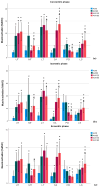Scapular Muscle Activation at Different Shoulder Abduction Angles During Pilates Reformer Arm Work Exercise
- PMID: 40282934
- PMCID: PMC12029123
- DOI: 10.3390/medicina61040645
Scapular Muscle Activation at Different Shoulder Abduction Angles During Pilates Reformer Arm Work Exercise
Abstract
Background and Objectives: Scapular muscles are crucial in controlling scapular movement, ensuring proper alignment, and preventing injuries during shoulder joint motion. The shoulder abduction angle is one of the most important factors when performing exercises to improve scapular movement control. The Pilates reformer arm work (AW) movement can be performed with different shoulder abduction angles. Therefore, this study analyzed the differences in scapular muscle activation depending on the shoulder abduction angle during the AW movement. Materials and Methods: Twenty-six healthy adult males performed the AW movement under four shoulder abduction angle conditions (0°, 90°, 135°, 160°). When performing the AW in the four conditions, surface electromyography analyzed the muscle activation of the upper trapezius (UT), middle trapezius (MT), lower trapezius (LT), serratus anterior (SA), posterior deltoid (PD), and levator scapulae (LS), and the muscle activation ratios of the UT/LT, LS/LT, UT/SA, and LS/SA. Results: The UT, LT, and SA muscle activation increased proportionally with the increasing shoulder abduction angle (p < 0.001). The LT showed the highest muscle activity at the shoulder abduction angle of 135° (p < 0.001). The MT and PD showed the highest muscle activities at the shoulder abduction angle of 90° (p < 0.001). The muscle activity ratios of the UT/LT and LS/LT were the lowest at the shoulder abduction angles of 90° and 135° (p < 0.001). The muscle activity ratio between the UT/SA and LS/SA was the lowest at the 135° and 160° shoulder abduction angles (p < 0.001). Conclusions: Our findings highlight the impact of the shoulder abduction angle on scapular muscle activation, suggesting that different angles may be used to engage specific muscles during Pilates reformer arm work exercises selectively. This insight can guide exercise interventions for individuals aiming to improve their scapular control and stability.
Keywords: Pilates reformer arm work; electromyography; scapular muscle; shoulder abduction.
Conflict of interest statement
The authors declare no conflicts of interest.
Figures



References
-
- Saçlı V., Çatalbaş M. The effect of Pilates exercises on functional movement screening: A systematic review. Adv. Health Exerc. 2025;5:8–14.
-
- Altunalan T., Çalik M., Kapanşahin M. Effect of Eight Weeks of Reformer Pilates on Shoulder Proprioception Dynamic Stability and Functionality. Bezmialem Sci. 2024;12:239–245. doi: 10.14235/bas.galenos.2024.46363. - DOI
MeSH terms
LinkOut - more resources
Full Text Sources

